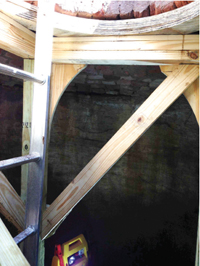A LITTLE PIECE OF HISTORY | By Joan Frances
Photos courtesy of the Fort Bend Archaeological Society –

The Lamar Cistern unearthed by Paul Spana and his team.
Discovering history is like a mystery waiting to be solved. Finding artifacts of the past in old buildings, abandoned homes and buried deep in the soil is an exciting adventure for historians. When relics are unearthed and studied, so many questions are elucidated. The Fort Bend Archeological Society (FBAS) was created in 1992, “to promote scientific archeological exploration and research for the preservation and conservation of archeological materials and sites, and most importantly, to educate its membership and the public to the aims of archeology.” Thanks to thousands of volunteer hours spent excavating different areas in Fort Bend County, amazing items have been discovered dating back to both prehistoric and historic events.
Paul Spana, president of the Fort Bend Archeological Society and lecturer, has been a devoted digger for 20 years. He is passionate and committed to discovering hidden history. Spana and his team have spent countless hours of calculations and research to find the right locations to excavate. The grave of Erastus “Deaf” Smith, best known as the scout for General Sam Houston, is one challenge that Spana and his team set out to discover. He was buried in the Episcopal churchyard in 1837 near what today is the intersection of 6th and Houston Streets. When the church was relocated many years later, Smith’s grave was forgotten. In an effort to locate the grave, the archeological volunteers and the Cemetery Committee of the Fort Bend County Historical Commission searched the intersection using ground-penetrating radar. The radar detected about seven anomalies, and six pits were dug, but no sign of any remains were found. The seventh anomaly was found on the street but not investigated. The dig was not a total loss, however, as many artifacts were discovered behind the museum from the Moore Family home. Dated around the turn of the century, the treasure hunters found coins, buttons, ceramics, shell casings and a ring. The location of the grave of “Deaf” Smith will remain a mystery, for now.

Inside the Lamar Cistern.
Spana and his team were very successful in the discovery of a group of Indian graves near Fulshear. FBAS worked alongside the Houston Archeological Society to excavate an Indian burial site known as the Bowser Site. This was one of the first archeological sites registered in Fort Bend County. The year-long excavations uncovered over 40 burials. Radiocarbon dating techniques showed the age of the burials to be approximately 3,300 years old. Many of the burials were adorned with shell and bone ornamentations. Other artifacts discovered included stone tools, arrowheads and boat-stones. One interesting artifact was a copper pin about the size of a knitting needle. It is unusual due to the fact that the only copper available to people at that time was from the upper areas of Michigan or perhaps the southwest region of the country. Since the artifact was found in Fulshear, this showed evidence of long distant trading. It is estimated the burials uncovered represent just part of the many more that may still be there.
One of the largest items the team unearthed was an old cistern. Built around the 1850s, this underground storage container was made of brick and plaster used to store rain water in the days before plumbing. Spana and his team removed a big metal hand pump for a water well, a box spring and metal remains from a wood-burning stove.
The Fort Bend County Museum is home to the artifacts discovered at the Bowser site, in addition to other areas. A collection of arrowheads, knives, jewelry, carved bone, shells and primitive objects from the Indians who lived several hundred years ago are a fascinating tribute to Fort Bend history.